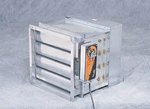Measuring and Controlling Outside Air

The most common system uses a minimum outside damper air measuring station combination that controls the outside air coming into the building when the main outside damper closes. Air measuring stations have a minimum limit around 400 fpm, which is sensing approximately .01" of velocity pressure. The control at this point is 5% of the cfm being measured or 750 cfm out of 15,000 cfm. With the minimum outside control, you only measure and control the air when the main outside air damper is closed.
There is also a system that uses multiple damper air measuring stations to control the total amount of outside air introduced into the building. These systems close off dampers as the demand for outside air decreases and keeps the control signal pressure high enough to maintain good accuracy.
Another system design uses a fan damper and air measuring system to force the minimum amount of outside air into the air mixing chamber. This type of system works well, however, it requires a large amount of space to put the package together.
The last system is a combination air measuring station integrated with the damper blades to form a compact package to measure and control the outside air. The damper is controlled by the pressure drop across the damper. The advantage of this type of control is the pressure drop across the unit when the blades are in a controlling position is in excess of .20" of pressure. This allows the pressure controller to give accurate readings even when there is only 150 fpm face velocity through the damper. With this device the outside air can be controlled from full outside air down to minimum outside air all in one package. And, naturally, if it works for the whole outside air damper it will also work as a minimum outside air damper.
The integrated measuring station damper gives an output of the cfm being delivered through the damper and the capabilities of resetting the amount of outside air required from the building automation system. This type of system is used in theaters to control the amount of outside air introduced into the air handling system based upon the number of ticket sales in the theater. By providing an exact mix to meet the needs of the space, the theater owner can realize substantial energy savings.
As you can see, there are several ways to adequately ventilate a building and control the amount of outside air mixed into a system. By doing so, you can meet the requirements of ASHRAE 62, eliminate Sick Building Syndrome and improve operating efficiency.
Comments are closed for this post, but if you have spotted an error or have additional info that you think should be in this post, feel free to contact us.